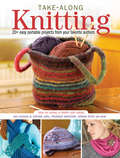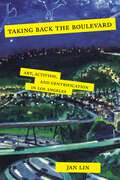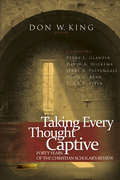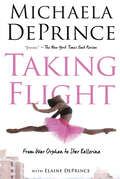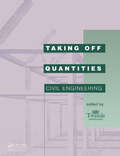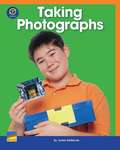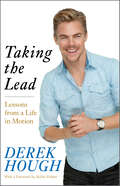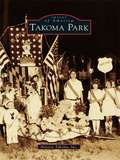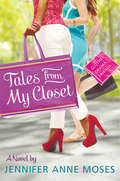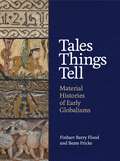- Table View
- List View
Take-2: 50 Films That Deserve a New Audience
by Deepa GahlotAn essential resource for scholars, connoisseurs and serious fans of Indian cinema, Take-2 makes for an entertaining, informative and nostalgia-filled read In the last few years there has been a glut of books on Indian cinema but most of them focus on the life and times of famous stars or celebrate popular film classics. Even though information and film trivia are now easier to access than ever before, some films have completely disappeared with not even a single print available due to reasons both tragic and strange. Also lost in time are some filmmakers and actors who once added their bit to the history of Indian cinema but have now simply vanished from our collective memory.In Take-2, Deepa Gahlot reacquaints or introduces us to 50 films (and many artistes) that merit our attention. While some on this list were chosen because they were the first Indian films of their kind, or were obscure films by well-known directors, others deserve mention because they were by creative talents whose contribution to Hindi cinema has been overlooked. Gahlot’s mission to rescue and preserve these forgotten gems should inspire us to go back and take another look.
Take-Along Knitting: 20+ Easy Portable Projects from Your Favorite Authors
by Editors of North Light BooksTake your knitting on the run!Are you a take-along knitter? Are you tempted to break out the needles in the library, on the bus, or even at the supermarket? Then Take-Along Knitting is for you! North Light editors have selected the best portable projects from our superstar authors, including Stefanie Japel, Jane Davis, Hannah Fettig and more, all gathered in one place. With easy-to-follow patterns that celebrate the joys of knitting everywhere you go, you'll be ready to take your knitting around the world!Take-Along Knitting features:Over 20 fabulous patterns—from luscious scarves to cozy mittens to stylish earrings—designed to be tucked in a backpack or briefcase for portabilityA handy reference guide that covers techniques from basic knitting and purling to embellishments, embroidery, felting and cablingValuable tips and tricks to make your knitting easier to take with youWhat are you waiting for? Grab the yarn and needles and head out the door!
Takedown: Art and Power in the Digital Age
by Farah NayeriFarah Nayeri addresses the difficult questions plaguing the art world, from the bad habits of Old Masters, to the current grappling with identity politics.For centuries, art censorship has been a top-down phenomenon--kings, popes, and one-party states decided what was considered obscene, blasphemous, or politically deviant in art. Today, censorship can also happen from the bottom-up, thanks to calls to action from organizers and social media campaigns. Artists and artworks are routinely taken to task for their insensitivity. In this new world order, artists, critics, philanthropists, galleries and museums alike are recalibrating their efforts to increase the visibility of marginalized voices and respond to the people&’s demands for better ethics in art. But what should we, the people, do with this newfound power? With exclusive interviews with Nan Goldin, Sam Durant, Faith Ringgold, and others, Nayeri tackles wide-ranging issues including sex, religion, gender, ethics, animal rights, and race. By asking and answering questions such as: Who gets to make art and who owns it? How do we correct the inequities of the past? What does authenticity, exploitation, and appropriation mean in art?, Takedown provides the necessary tools to navigate the art world.
Taking AIM!: The Business of Being an Artist Today
by Marysol NievesTaking Aim! The Business of Being an Artist Today is a practical, affordable resource guide filled with invaluable advice for the emerging artist. The book is specially designed to aid visual artists in furtheringtheir careers through unfiltered information about the business practices and idiosyncrasies of the contemporary art world. It demystifies often daunting and opaque practices through first-hand testimonials, interviews, and commentary from leading artists, curators, gallerists, collectors, critics, art consultants, arts administrators, art fair directors, auction house experts, and other art world luminaries.Published in celebration of the 30th anniversary of Artist in the Marketplace (AIM)—the pioneering career development program at the Bronx Museum of the Arts—Taking AIM! The Business of Being an Artist Today mirrors the structure and topics featured in the AIM program’s weekly workshops and discussions. Each chapter focuses on the specific perspective of an “art world insider”—from the artist to the public art program director to the blogger. Multiple viewpoints from a range of art professionals provide emerging artists with candid, uncensored information and tools to help them better understand this complex field and develop strategies for building and sustaining successful careers as professional artists.The book ends with an annotated chronology of the past three decades in the contemporary art field and a bibliography of publications, magazine articles, online sources, funding sources, residency programs, and other useful information for emerging artists.
Taking Back the Boulevard: Art, Activism, and Gentrification in Los Angeles
by Jan LinThe promises and conflicts faced by public figures, artists, and leaders of Northeast Los Angeles as they enliven and defend their neighborhoods Los Angeles is well known as a sprawling metropolis with endless freeways that can make the city feel isolating and separate its communities. Yet in the past decade, as Jan Lin argues in Taking Back the Boulevard, there has been a noticeable renewal of public life on several of the city’s iconic boulevards, including Atlantic, Crenshaw, Lankershim, Sunset, Western, and Wilshire. These arteries connect neighborhoods across the city, traverse socioeconomic divides and ethnic enclaves, and can be understood as the true locational heart of public life in the metropolis. Focusing especially on the cultural scene of Northeast Los Angeles, Lin shows how these gentrifying communities help satisfy a white middle-class consumer demand for authentic experiences of “living on the edge” and a spirit of cultural rebellion. These neighborhoods have gone through several stages, from streetcar suburbs, to disinvested neighborhoods with the construction of freeways and white flight, to immigrant enclaves, to the home of Chicano/a artists in the 1970s. Those artists were then followed by non-Chicano/a, white artists, who were later threatened with displacement by gentrifiers attracted by the neighborhoods’ culture, street life, and green amenities that earlier inhabitants had worked to create. Lin argues that gentrification is not a single transition, but a series of changes that disinvest and re-invest neighborhoods with financial and cultural capital. Drawing on community survey research, interviews with community residents and leaders, and ethnographic observation, this book argues that the revitalization in Northeast LA by arts leaders and neighborhood activists marks a departure in the political culture from the older civic engagement to more socially progressive coalition work involving preservationists, environmentalists, citizen protestors, and arts organizers. Finally, Lin explores how accelerated gentrification and mass displacement of Latino/a and working-class households in the 2010s has sparked new rounds of activism as the community grapples with new class conflicts and racial divides in the struggle to self-determine its future.
Taking Blender to the Next Level: Implement advanced workflows such as geometry nodes, simulations, and motion tracking for Blender production pipelines
by Ruan LotterA comprehensive guide with key images printed in color to learning motion graphics, character modeling and rigging, creating dynamic hair and clothes, 3D scanning using photogrammetry, and moreKey FeaturesLearn how to use geometry nodes to create motion graphics and dynamic scenesUnderstand organic 3D modeling and how to create and animate your own 3D charactersUse physics simulations to create clothing and hair for characters that interact with forces like windBook DescriptionIf you're ready to start exploring the more advanced workflows and processes in Blender to create intricate 3D models, then Taking Blender to the Next Level is for you.This book focuses on a few different VFX-related workflows such as geometry nodes, organic modeling, 3D camera tracking, photogrammetry, sculpting, compositing, and physics simulations. You'll learn how to use geometry nodes to create dynamic motion graphic scenes as well as perform 3D scanning of real-world objects using photogrammetry. You'll also find out how to model, rig, and animate your own 3D characters from scratch. Next, you'll progress to using simulations to break objects apart and then use cloth and hair simulations to add realism to your 3D creations. Finally, you'll go over the final render settings and export your 3D animation masterpiece as a video.By the end of this Blender book, you'll be able to model your own 3D characters, objects, and landscapes; rig, animate, and texture your characters; 3D track live-action footage; and composite your 3D characters into live-action scenes.What you will learnUse geometry nodes to quickly create complex 3D scenes and motion graphics rendersCreate realistic textures using physically based rendering materials3D scan real-life objects using a normal camera and clean up the model using BlenderUnderstand how to model, rig, and animate your own 3D charactersUse rigid body simulations to create dynamic scenesUnderstand how to perform 3D tracking within BlenderBecome well-versed with compositing 3D renders into live-action footageWho this book is forThis Blender 3D book is for 3D modelers, texture artists, character and technical animators, matchmove artists, compositors, and anyone interested in learning advanced concepts in Blender. Motion graphics artists will also benefit from this book. A solid understanding of 3D concepts and the Blender UI is needed to grasp the concepts present in this book.
Taking Every Thought Captive: Forty Years of the Christian Scholar's Review
by Don W. KingTaking Every Thought Captive celebrates forty years of the Christian Scholar's Review by collecting a representation of the best scholarship to appear in its pages from inception in 1970 through 2010.Over its forty years of publication, CSR has had two main objectives: "the integration of Christian faith and learning on both the intra- and inter-disciplinary levels" and "to provide a forum for the discussion of the theoretical issues of Christian higher education."The twenty-four articles gathered in this anniversary collection reflect both of these objectives. As a whole, this collection witnesses to the rigors of the intellectual enterprise found within the pages of CSR and affirms an ongoing commitment to support, enhance, and promote Christian scholarship.Contributors include: Carl F. H. Henry, Arthur F. Holmes, George Marsden, Mary Stewart Van Leeuwen, Stanley Hauerwas, Richard J. Mouw, Mark A. Noll, Dallas Willard, Elizabeth Newman, Roger Lundin, Nancy Ammerman, Nicholas Wolterstorff, and fifteen others.
Taking Exception to the Law: Materializing Injustice in Early Modern English Literature
by Edited by Donald Beecher Travis Decook Andrew Wallace Grant WilliamsTaking Exception to the Law explores how a range of early modern English writings responded to injustices perpetrated by legal procedures, discourses, and institutions. From canonical poems and plays to crime pamphlets and educational treatises, the essays engage with the relevance and wide appeal of legal questions in order to understand how literature operated in the early modern period. Justice in its many forms – legal, poetic, divine, natural, and customary – is examined through insightful and innovative analyses of a number of texts, including The Merchant of Venice, The Faerie Queene, and Paradise Lost. A major contribution to the growing field of law and literature, this collection offers cultural contexts, interpretive insights, and formal implications for the entire field of English Renaissance culture.
Taking Flight: From War Orphan to Star Ballerina
by Michaela Deprince Elaine DeprinceMichaela DePrince was known as girl Number 27 at the orphanage, where she was abandoned at a young age and tormented as a "devil child" for a skin condition that makes her skin appear spotted. But it was at the orphanage that Michaela would find a picture of a beautiful ballerina en pointe that would help change the course of her life. At the age of four, Michaela was adopted by an American family, who encouraged her love of dancing and enrolled her in classes. She went on to study at the Jacqueline Kennedy Onassis School at the American Ballet Theatre and is now the youngest principal dancer with the Dance Theatre of Harlem. She has appeared in the ballet documentary First Position, as well as on Dancing with the Stars, Good Morning America, and Nightline. In this engaging, moving, and unforgettable memoir, Michaela shares her dramatic journey from an orphan in West Africa to becoming one of ballet's most exciting rising stars.
Taking Flight: Inspiration And Techniques To Give Your Creative Spirit Wings
by Kelly Rae RobertsStretch Your Wings, Learn to Soar, Take FlightIn Taking Flight, you'll find overflowing inspiration–complete with a kindred spirit in author and mixed-media artist Kelly Rae Roberts. Join her on a fearless journey into the heart of creativity as you test your wings and learn to find the sacred in the ordinary, honor your memories, speak your truth and wrap yourself in the arms of community.Along the way you'll be inspired by:Step-by-step techniques–learn the most-loved mixed-media methods of the author and seven talented contributing artists, and combine them in fresh and unexpected ways.Thought-provoking prompts and quotes–along with encouraging stories, insights and gentle guidance for finding your bliss, whatever your art or craft.Plenty of eye-candy–pages and pages of the author's endearing artwork, along with the varied works of the contributors.Of course, learning to fly isn't entirely a step-by-step process–sooner or later, you just need to take a deep breath and spread your wings. With Taking Flight as your guide, there's no doubt that when you do, your creativity will soar.
Taking Funny Music Seriously (Comedy & Culture)
by Lily E. HirschTake funny music seriously! Though often dismissed as silly or derivative, funny music, Lily E. Hirsch argues, is incredibly creative and dynamic, serving multiple aims from the celebratory to the rebellious, the entertaining to the mentally uplifting. Music can be a rich site for humor, with so many opportunities that are ripe for a comedic left turn. Taking Funny Music Seriously includes original interviews with some of the best musical humorists, such as Tom Lehrer, "the J. D. Salinger of musical satire"; Peter Schickele, who performed as the invented composer P. D. Q. Bach, the supposed lost son of the great J. S. Bach; Kate Micucci and Riki Lindhome of the funny music duo Garfunkel and Oates; comedic film composer Theodore Shapiro; Too Slim of the country group Riders in the Sky; and musical comedian Jessica McKenna, from the podcast Off Book, part of a long line of "funny girls." With their help, Taking Funny Music Seriously examines comedy from a variety of genres and musical contexts—from bad singing to rap, classical music to country, Broadway music to film music, and even love songs and songs about death.In its coverage of comedic musical media, Taking Funny Music Seriously is an accessible and lively look at funny music. It offers us a chance to appreciate more fully the joke in music and the benefits of getting that joke—especially in times of crisis—including comfort, catharsis, and connection.
Taking Off Quantities: Civil Engineering (Spon's Price Books)
by Bryan SpainThis book provides a thorough understanding of the general principles of measurement for taking off quantities. An essential guide to any quantity surveyor, architect or engineer. Taking off quantities: Civil Engineering demonstrates, through a series of detailed worked examples from a range of civil engineering projects, how the measurement techni
Taking Photographs
by Lynne AndersonLearn how to make a pinhole camera. (Set of 6 with Common Core Editions of Teacher Materials)
Taking [A]part: The Politics and Aesthetics of Participation in Experience-Centered Design (Design Thinking, Design Theory)
by Peter Wright John McCarthyA critical inquiry into the value and experience of participation in design research.In Taking [A]part, John McCarthy and Peter Wright consider a series of boundary-pushing research projects in human-computer interaction (HCI) in which the design of digital technology is used to inquire into participative experience. McCarthy and Wright view all of these projects—which range from the public and performative to the private and interpersonal—through the critical lens of participation. Taking participation, in all its variety, as the generative and critical concept allows them to examine the projects as a part of a coherent, responsive movement, allied with other emerging movements in DIY culture and participatory art. Their investigation leads them to rethink such traditional HCI categories as designer and user, maker and developer, researcher and participant, characterizing these relationships instead as mutually responsive and dialogical.McCarthy and Wright explore four genres of participation—understanding the other, building relationships, belonging in community, and participating in publics—and they examine participatory projects that exemplify each genre. These include the Humanaquarium, a participatory musical performance; the Personhood project, in which a researcher and a couple explored the experience of living with dementia; the Prayer Companion project, which developed a technology to inform the prayer life of cloistered nuns; and the development of social media to support participatory publics in settings that range from reality game show fans to on-line deliberative democracies.
Taking a Stand: Contemporary US Stand-Up Comedians as Public Intellectuals
by Jared N. Champion and Peter C. KunzeContributions by Jared N. Champion, Miriam M. Chirico, Thomas Clark, David R. Dewberry, Christopher J. Gilbert, David Gillota, Kathryn Kein, Rob King, Rebecca Krefting, Peter C. Kunze, Linda Mizejewski, Aviva Orenstein, Raúl Pérez, Philip Scepanski, Susan Seizer, Monique Taylor, Ila Tyagi, and Timothy J. Viator Stand-up comedians have a long history of walking a careful line between serious and playful engagement with social issues: Lenny Bruce questioned the symbolic valence of racial slurs, Dick Gregory took time away from the stage to speak alongside Martin Luther King Jr., and—more recently—Tig Notaro challenged popular notions of damaged or abject bodies. Stand-up comedians deploy humor to open up difficult topics for broader examination, which only underscores the social and cultural importance of their work. Taking a Stand: Contemporary US Stand-Up Comedians as Public Intellectuals draws together essays that contribute to the analysis of the stand-up comedian as public intellectual since the 1980s. The chapters explore stand-up comedians as contributors to and shapers of public discourse via their live performances, podcasts, social media presence, and political activism. Each chapter highlights a stand-up comedian and their ongoing discussion of a cultural issue or expression of a political ideology/standpoint: Lisa Lampanelli’s use of problematic postracial humor, Aziz Ansari’s merging of sociology and technology, or Maria Bamford’s emphasis on mental health, to name just a few. Taking a Stand offers a starting point for understanding the work stand-up comedians do as well as its reach beyond the stage. Comedians influence discourse, perspectives, even public policy on myriad issues, and this book sets out to take those jokes seriously.
Taking the Lead: Lessons from a Life in Motion
by Derek HoughThe Emmy Award winner and only five-time champion of the hit ABC reality show Dancing with the Stars tells the inspiring story of his life and career.For eleven seasons, millions of people have tuned in to Dancing with the Stars to watch Derek Hough, the talented, consummate competitor whose skill and commitment have made him the show’s all-time champion. Whether he’s dancing with an Olympic gold medalist, an internationally renowned recording star, or a celebrated actress, Derek instills in each of his celebrity partners a deep passion, respect for hard work, and an irrepressible joie de vie spirit.Now, for the first time ever, Derek opens up about his life and the lessons he’s learned on and off the dance floor, revealing how he went from bullied boy to ballroom boss. He details how his experiences have taught him to embrace a positive outlook, and shares the insights he’s gained working with celebrity partners, along with never-before-told, behind-the-scenes stories from the show.Throughout, Derek spills the real secrets of learning to dance—connection, respect, and cooperative commitment—and demonstrates how he draws on the lessons of dance and competition to embrace and overcome the daily challenges we all face.
Taking the Soviet Union Apart Room by Room: Domestic Architecture before and after 1991 (NIU Series in Slavic, East European, and Eurasian Studies)
by Kateryna MalaiaTaking the Soviet Union Apart Room by Room investigates what happens to domestic spaces, architecture, and the lives of urbanites during a socioeconomic upheaval. Kateryna Malaia analyzes how Soviet and post-Soviet city dwellers, navigating a crisis of inadequate housing and extreme social disruption between the late 1980s and 2000s, transformed their dwellings as their countries transformed around them. Soviet infrastructure remained but, in their domestic spaces, urbanites transitioned to post-Soviet citizens. The two decades after the collapse of the USSR witnessed a major urban apartment remodeling boom. Malaia shows how, in the context of limited residential mobility, those remodeling and modifying their homes formed new lifestyles defined by increased spatial privacy. Remodeled interiors served as a material expression of a social identity above the poverty line, in place of the outdated Soviet signifiers of well-being. Connecting home improvement, self-reinvention, the end of state socialism, and the lived experience of change, Malaia puts together a comprehensive portrait of the era. Malaia shows both the stubborn continuities and the dramatic changes that accompanied the collapse of the USSR. Making the case for similarities throughout the former Soviet empire, this study is based on interviews and fieldwork done primarily in Kyiv and Lviv, Ukraine. Many of the buildings described are similar to those damaged or destroyed by Russian bombings or artillery fire following the invasion of Ukraine on February 24, 2022. A book about major historic events written through the lens of everyday life, Taking Soviet Union Apart is also about the meaning of home in a dramatically changing world.
Taking the Soviet Union Apart Room by Room: Domestic Architecture before and after 1991 (NIU Series in Slavic, East European, and Eurasian Studies)
by Kateryna MalaiaTaking the Soviet Union Apart Room by Room investigates what happens to domestic spaces, architecture, and the lives of urbanites during a socioeconomic upheaval. Kateryna Malaia analyzes how Soviet and post-Soviet city dwellers, navigating a crisis of inadequate housing and extreme social disruption between the late 1980s and 2000s, transformed their dwellings as their countries transformed around them. Soviet infrastructure remained but, in their domestic spaces, urbanites transitioned to post-Soviet citizens. The two decades after the collapse of the USSR witnessed a major urban apartment remodeling boom. Malaia shows how, in the context of limited residential mobility, those remodeling and modifying their homes formed new lifestyles defined by increased spatial privacy. Remodeled interiors served as a material expression of a social identity above the poverty line, in place of the outdated Soviet signifiers of well-being. Connecting home improvement, self-reinvention, the end of state socialism, and the lived experience of change, Malaia puts together a comprehensive portrait of the era. Malaia shows both the stubborn continuities and the dramatic changes that accompanied the collapse of the USSR. Making the case for similarities throughout the former Soviet empire, this study is based on interviews and fieldwork done primarily in Kyiv and Lviv, Ukraine. Many of the buildings described are similar to those damaged or destroyed by Russian bombings or artillery fire following the invasion of Ukraine on February 24, 2022. A book about major historic events written through the lens of everyday life, Taking Soviet Union Apart is also about the meaning of home in a dramatically changing world.
Takoma Park
by Inc. Historic TakomaThe story of Takoma Park begins in 1883 when B. F. Gilbert purchased 90 acres of hilly woodlands straddling the District of Columbia-Maryland border and laid out Washington's first railroad suburb, ideally situated for the families of federal workers. Envisioning a healthful and forward-looking community, Gilbert also arranged for leaders of the health-minded Seventh-day Adventist Church to move to Takoma Park. By the early 20th century, the town was well established, and residents were creating traditions to pass on to those who followed, including an Independence Day celebration that is one of the oldest in the state. Community activism has been a hallmark of Takoma Park since a 1965 plan to build a freeway through the heart of the town. This sparked a citizen-led protest that stopped construction and led to the creation of historic districts on both sides of the D.C.-Maryland boundary line. The city's reputation as a feisty and culturally diverse community continues to be a source of pride, attracting artists, activists, and new residents from countries around the world.
Talbot County
by R. Jerry Keiser Barbara Thompson LewisSituated on the Eastern Shore of Maryland on the Chesapeake Bay, Talbot County, with its many rivers, creeks, inlets, and islands, boasts 600 miles of scenic shoreline. The birthplace of Frederick Douglass, Talbot County has a rich history of waterfront towns and villages and a serene beauty and tradition, which made the county the ideal setting for Pulitzer Prize-winning author James Michener's novel Chesapeake. Easton, the county seat, is home to the Third Haven Meeting House, which was built in 1661 and is the oldest wooden church still in use in America. In Images of America: Talbot County, historical documents, vintage postcards, photographs of local families, and other memorabilia depict the county's people, places, and pastimes. This volume features prominent Talbot County figures as well as many images of Easton, St. Michaels, Oxford, Trappe, Tilghman Island, and other remarkable locations.
Tales From My Closet
by Jennifer Anne MosesFive girls. A paper dress. Tons of shoes. One unforgettable raincoat. White Jeans. Secrets. Drama. Friends?For Justine, Bianca, Becka, Polly, and Anne, living in Westfield, New Jersey is "life on planet toilet paper." At least that's how Justine feels when she shows up as the new girl in school wearing a Scott Paper Caper dress. To her, it's a super-original fashion statement. But other "loser freaks" don't agree. The other girls have their own fashion issues, ranging from fabulous boots to raggedy pajamas to what to wear to therapy. Told in alternating voices, TALES FROM MY CLOSET follows the stories of high school kids who have nothing in common--and everything in common. They're at war with each other, but through their clothes, they reveal and conceal themselves and make peace with what it means to be a teen. Over the course of a school year, their individual struggles and successes come together to tell a story that's funny, honest, and all-girl fabulous.
Tales From the Loop
by Simon StålenhagThe basis for the new Amazon Prime Original Series! Perfect for fans of E.T. and Stranger Things—the first narrative artbook from acclaimed author and artist Simon Stålenhag about a fictionalized suburban town in the 1980s inhabited by fantastic machines and strange, imaginative beasts.In 1954, the Swedish government ordered the construction of the world&’s largest particle accelerator. The facility was complete in 1969, located deep below the pastoral countryside of Mälaröarna. The local population called this marvel of technology The Loop. These are its strange tales. From the same author who wrote the imaginative artbook The Electric State, this &“haunting,&” (The Verge) &“sophisticated sci-fi&” (The Nerdist) follows the bizarre stories from otherworldly creatures and is a page-turner you won&’t be able to put down.
Tales Things Tell: Material Histories of Early Globalisms
by Finbarr Barry Flood Beate FrickeNew perspectives on early globalisms from objects and imagesTales Things Tell offers new perspectives on histories of connectivity between Africa, Asia, and Europe in the period before the Mongol conquests of the thirteenth century. Reflected in objects and materials whose circulation and reception defined aesthetic, economic, and technological networks that existed outside established political and sectarian boundaries, many of these histories are not documented in the written sources on which historians usually rely. Tales Things Tell charts bold new directions in art history, making a compelling case for the archival value of mobile artifacts and images in reconstructing the past.In this beautifully illustrated book, Finbarr Barry Flood and Beate Fricke present six illuminating case studies from the sixth to the thirteenth centuries to show how portable objects mediated the mobility of concepts, iconographies, and techniques. The case studies range from metalwork to stone reliefs, manuscript paintings, and objects using natural materials such as coconut and rock crystal. Whether as booty, commodities, gifts, or souvenirs, many of the objects discussed in Tales Things Tell functioned as sources of aesthetic, iconographic, or technical knowledge in the lands in which they came to rest. Remapping the histories of exchange between medieval Islam and Christendom, from Europe to the Indian Ocean, Tales Things Tell ventures beyond standard narratives drawn from written archival records to demonstrate the value of objects and images as documents of early globalisms.
Tales from the Back Row: An Outsider's View from Inside the Fashion Industry
by Amy OdellA keenly observed collection of personal essays about what it’s like to be a young woman working in the fashion industry, Amy Odell’s Tales from the Back Row offers “a backstage pass to the intimidating, backbiting industry” (US Weekly).In the “funny, insightful” (Harper’s Bazaar) Tales from the Back Row, Cosmopolitan.com editor Amy Odell takes readers behind the stage of New York’s hottest fashion shows to meet the world’s most influential models, designers, celebrities, editors, and photographers. But first, she has to push her way through the crowds outside and weave her way through the packed venue, from the very back row to the front. And as Amy climbs the ladder (with tips about how you can, too), she introduces an industry powered by larger-than-life characters: she meets the intimidating Anna Wintour and the surprisingly gracious Rachel Zoe, not to mention the hilarious Chelsea Handler, and more. As she describes the allure of Alexander Wang’s ripped tights and Marchesa’s Oscar-worthy dresses, Amy layers in something else: how the fashion industry is an exaggerated mirror of human fallibility—reflecting our desperate desire to belong, to make a mark. In her “light-hearted, cocktail-hour confession from someone who is…sober enough to recognize insanity for what it is” (The Washington Post), Amy is the first to admit that as much as she is embarrassed by the thrill she gets when she receives an invitation to an exclusive after-party, she can’t help but RSVP “yes.” Welcome to the weird and wonderful world of high fashion: “Whether you’re interested in pursuing a career in publishing, public relations, or design, or you’re just fascinated with what really goes on behind-the-scenes without the usual sugarcoating, we’d say this is required reading” (Fashionista.com).
Tales from the Big House: 400 Years of Its History and People
by Stephen WadeTales from the Big House: Normanby Hall tells the story of a place known perhaps today mainly as the home where Samantha Cameron grew up, but historically it has been the seat of the Sheffield family, whose most famous member was arguably the Duke of Buckingham in the seventeenth century. As with most country houses, the Hall was used as a military hospital in the Great War, and in the Second World War there were military personnel based there again. It stands just a few miles from the great steelworks on the Brigg Road, which have always defined Scunthorpe, so it played its part in the history of steel-making also.The book includes biographies of the famous but also tells of the lives of the ordinary people who kept the house and the estate going, from the gamekeepers to the gardeners, and the cooks to the stable hands. All this is set against the social background through the centuries of its existence, up to the sale of the Hall to Scunthorpe Borough Council in 1964. The lives familiar to us today from Downton Abbey and similar family sagas are at the heart of Stephen Wades history. But along the way, the reader will meet such characters as Sir Berkeley Sheffield, model railway enthusiast, Walter Brierley, architect, Thomas Sumpter, the schoolmaster, John Fletcher, machine-maker, and perhaps most charismatically of all, Lady Arthur Grosvenor, an expert on gypsy caravans.

